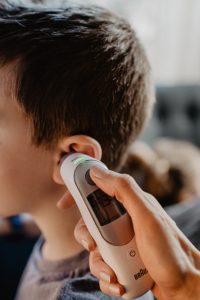3.10 Medical Plans
Individualized medical plans are developed for children requiring support for medical conditions or medical devices. For example, a child with a history of febrile seizures requires a medical plan to guide educators in knowing what symptoms to watch for, knowing when to administer non-prescription medication such as Tylenol, and knowing who to contact in the event of an emergency. Individualized medical plans are developed with input from the family, regulated medical professionals, and early years supervisors. If a child has anaphylaxis, the anaphylaxis plan will be used instead of the individualized medical plan.
Medical plans are reviewed by educators, early years setting employees, students, and volunteers prior to engaging with the child. The individualized medical plan is also posted in the classrooms where the child is present, with a copy available to educators when they are outdoors or on a field trip. This plan will accompany any medication required. If the medication is in a locked medicine box, a copy of the plan can be placed in a bag with the labelled medication. Educators ensure they have this locked medicine box with them on field trips, when outdoors, or during evacuations.
Download (PDF)
Medication Administration
Families will often request that medications be administered to their children when they are present in early years settings. Medications may include prescription medications or non-prescription medications. In order to reduce the opportunity for medication errors, licensed child care operators may encourage families to administer medication to the child when they are at home whenever possible. Licensed child care operators will not administer non-prescription medications without a very detailed letter from a doctor or nurse practitioner. Medications must always be provided by family members. Early years settings are not dispensaries; therefore, they cannot provide medications for children. Early years settings may refuse to administer medication, so it is important for early years settings to share their medication policies prior to a child’s enrollment. Licensed child care providers who administer medication develop detailed policies and protocols to ensure medication errors are minimal. Educators, students, and volunteers will be trained on these policies prior to working with children.
Regulation
Administration of Drugs or Medications
40. (1) Where a licensee agrees to the administration of drugs or medications, the licensee shall ensure that,
(a) a written procedure is established for,
(i) the administration of any drug or medication to a child receiving child care at a child care centre operated by the licensee or at a premises where it oversees the provision of home child care, and
(ii) the keeping of records with respect to the administration of drugs and medications;
(b) all drugs and medications on the premises of a child care centre operated by the licensee or at a premises where it oversees the provision of home child care are,
(i) stored in accordance with the instructions for storage on the label,
(ii) administered in accordance with the instructions on the label and the authorization received under clause (d),
(iii) inaccessible at all times to children, and
(iv) in the case of a child care centre, kept in a locked container;
(c) one person in each child care centre operated by the licensee and in each premises where it oversees the provision of home child care is in charge of all drugs and medications and that all drugs and medications are dealt with by that person or a person designated by that person in accordance with the procedures established under clause (a);
(d) a drug or medication is administered to a child only where a parent of the child gives written authorization for the administration of the drug or medication and that included with the authorization is a schedule that sets out the times the drug or medication is to be given and amounts to be administered; and
(e) a drug or medication is administered to a child only from the original container as supplied by a pharmacist or the original package and that the container or package is clearly labelled with the child’s name, the name of the drug or medication, the dosage of the drug or medication, the date of purchase and expiration, if applicable, and instructions for storage and administration. O. Reg. 137/15, s. 40 (1); O. Reg. 254/19, s. 10.
(2) Despite subclauses (1) (b) (iii) and (iv) and clause (1) (c), the licensee may permit a child to carry his or her own asthma medication or emergency allergy medication in accordance with the procedures established under clause (1) (a). O. Reg. 137/15, s. 40 (2).
(Ontario Regulation 137/15, under the Child Care and Early Years Act, 2014. © King’s Printer for Ontario, 2015)
Watch this helpful video to understand the importance of the 5 Rights of Safe Medication Administration:
Video: The “Five Rights” of Safe Medication Administration by The Early Childhood Education and Training Program [7:40]. Transcript available on YouTube.
Prescription Medication

Prescription medication may be administered if it is in its original container with a prescription label. The prescription label must contain the medication name, the child’s name, the doctor or nurse practitioner’s name, the dosage, the time to be administered, and the route for administration. The family member must complete a medication administration permission form with information matching the prescription label. Educators must ensure the permission form matches the prescription label before administering the medication. If the information isn’t aligned the educator cannot administer the medication until the family member signs off on a revised form.
Routes for administration may be through inhalation, ingestion (mouth), injection, or through the eyes, ears or nose with drops, ointments, or sprays. Medication must be kept in a locked container and out of the reach of children. If the medication needs to be refrigerated, a locked medication box will be stored in a refrigerator. Each time medication is administered the educator must document the child’s name, type of medication, the date of administration, the dosage amount, and sign off. This must be done immediately to ensure there is no double dosing. If this information is not documented another educator may administer the medication believing it had not already been administered. Educators must also note the administration of medication in the daily written record in the classroom.
Non-Prescription Medication
Licensed child care organizations are hesitant to administer non-prescription medications for many reasons. Typically these medications come with less instructions for use, are not prescribed by a medical professional, do not have a dosage amount or time specific to the child, and may mask symptoms of illness. For example, a child may have a fever and need to be excluded from care. If the symptom of a fever is masked with fever reducing medication the child may remain in care, exposing other children to infectious diseases.
In the case of febrile seizures a family may provide written instructions by a doctor to administer fever reducing medication. The letter must contain the child’s name, the doctor’s name, the medication name, the dosage amount, when to administer the medication, and symptoms that must be present in order for the child to receive the medication. This letter must remain in the child’s file and be used in the creation of an individualized medical plan.
Some early years settings may allow parents to supply non-prescription medication for administration but the medication will need to be in its original container, accompanied by a doctor or nurse practitioner’s letter indicating all of the required information necessary for the medication to be safely administered to the child. The non-prescription medication container must be labeled with the child’s first and last name. The family member needs to complete a medication administration permission form. Educators must document each time the medication is administered.
Download (PDF)
Click link to download:
Exercise
Test Your Knowledge
Topical Ointments

Families are encouraged to provide ointments and lotions for their children. Some early years settings may provide topical ointments such as sunscreen but families must grant permission for these topical ointments to be used for their children. Educators must ensure ointments do not contain any allergens that may impact other children in the learning space. All topical ointments must be labeled with the child’s name. Expired topical ointments will be returned to the family for discarding. Topical ointments must be kept out of the reach of children. Children may help apply ointments such as sunscreen when they are old enough to do so.
Regulation
Administration of Drugs or Medications (Continued)
(3) The following items do not constitute drugs or medication for the purposes of this section, except where the item is a drug, as defined in the Drug and Pharmacies Regulation Act, prescribed for a child by a health professional:
- Sunscreen.
- Moisturizing skin lotion.
- Lip balm.
- Insect repellent.
- Hand sanitizer.
- Diaper cream. O. Reg. 174/21, s. 22.
(4) In respect of an item described in subsection (3) that does not constitute a drug or medication for the purposes of this section, a licensee shall ensure that,
(a) the item is administered to a child only if a parent of the child has given written authorization for the administration of the item;
(b) the item is stored in accordance with the instructions for storage on the label and the container or package is clearly labelled with the child’s name and the name of the item; and
(c) the item is administered to a child only from the original container or package and in accordance with any instructions on the label and any instructions provided by the parent of the child. O. Reg. 174/21, s. 22.
(Ontario Regulation 137/15, under the Child Care and Early Years Act, 2014. © King’s Printer for Ontario, 2015)
Many early years settings have developed topical ointment forms for parents to check off and sign to allow for changes to be made more easily as the child grows and changes over the years. It is important to note that sunscreen is not recommended for infants under 6 months of age. Families may also provide homemade ointments. Families should ensure there is a list of ingredients provided with homemade ointments to ensure they are allergen free. Other items that may be added to the topical ointment permission form include face paint, nail polish, and first aid ointments.
Download (PDF)
Click link to download:

